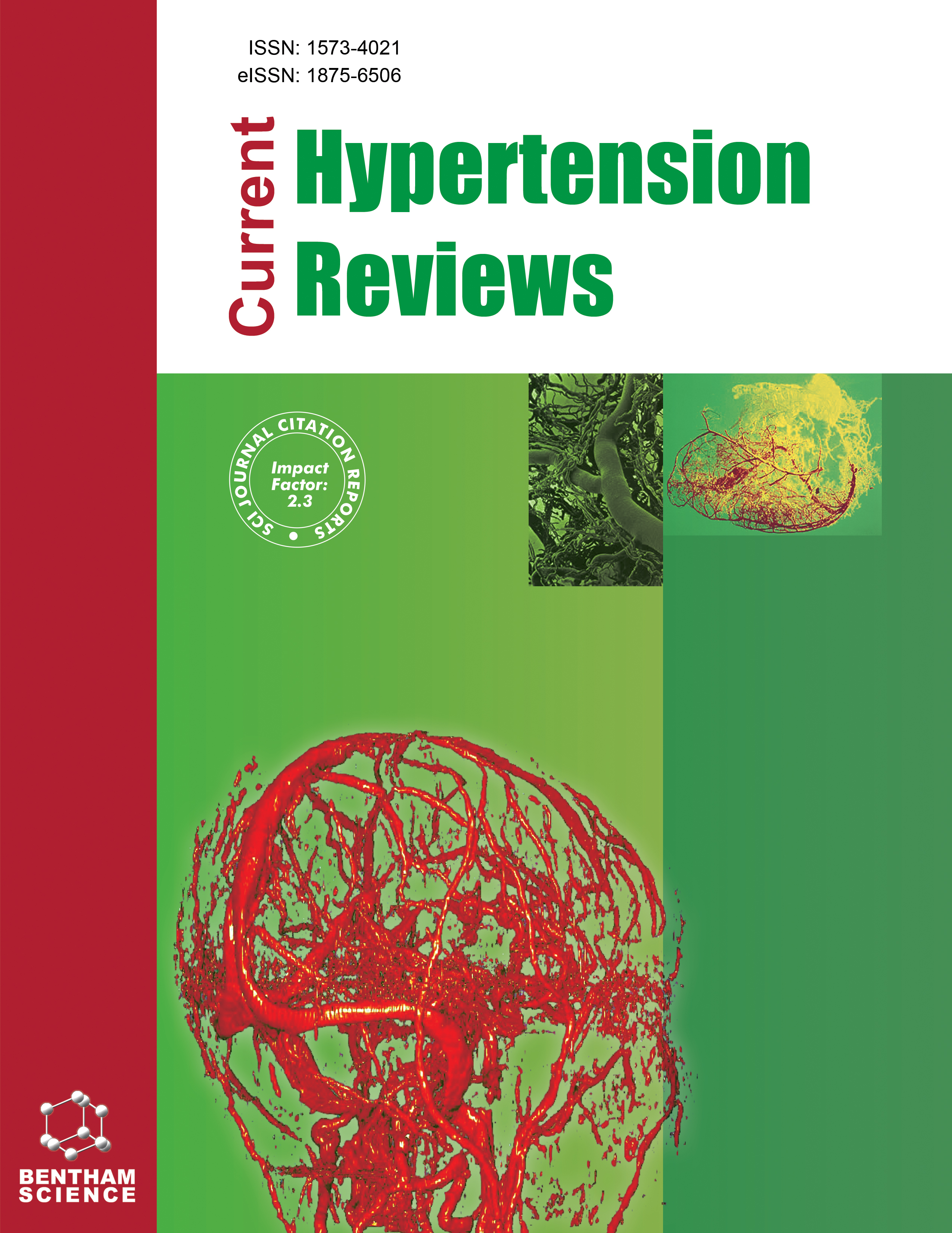- Home
- A-Z Publications
- Current Hypertension Reviews
- Previous Issues
- Volume 8, Issue 1, 2012
Current Hypertension Reviews - Volume 8, Issue 1, 2012
Volume 8, Issue 1, 2012
-
-
EDITORIAL [Hot Topic: Novel Therapeutic Targets of the Renin-Angiotensin System (Guest Editor: Rajesh Kumar)]
More LessBy Rajesh KumarRenin-angiotensin system (RAS) has a major role in hypertension, diabetes, obesity, and diseases that are caused by these conditions. Inhibition of the RAS has been clinically proven beneficial in hypertension, atherosclerosis, coronary artery disease, heart failure, stroke, nephropathy, and neuropathy, among many others. The dominant concept of the RAS defines this as a circulating system consisting of renin, angiotensino Read More
-
-
-
Could Additional Inhibitors of the Renin -Angiotensin System be Clinically Useful?
More LessAuthors: Richard N. Re and Julia L. CookThe renin-angiorensin system (RAS) is an important regulator of vascular volume and cardiovascular structure. Inhibitors of the RAS appear to provide benefits in addition to those associated with blood pressure lowering in disorders such as diabetic nephropathy, and congestive heart failure. Early successes led to the speculation that improved blockade of the RAS could produce further benefits. Although improved blo Read More
-
-
-
(Pro)renin Receptor: Pathological Role and Therapeutic Potential in Primary Hypertension
More LessAuthors: Kanako Bokuda, Atsuhiro Ichihara and Hiroshi ItohRenin-angiotensin system (RAS) is known to be a regulator of blood pressure, volume homeostasis, and cardiovascular growth and remodeling, but is still incompletely understood. Tissue RAS plays important roles in development of target-organ damages in pathological states such as hypertension and diabetes. The pathophysiological roles of (pro)renin receptor [(P)RR] have been growing concern. (P)RR binds renin an Read More
-
-
-
Impact of Mast Cell Chymase on Renal Disease Progression
More LessAuthors: Haimanot Wasse, Nawazish Naqvi and Ahsan HusainChymase, a serine protease found in mast cell granules, is released into the interstitium following injury or inflammation. Chymase is the primary ACE-independent pathway of angiotensin II formation, and also functions to activate TGF-beta and other promoters of extracellular matrix degradation, thereby playing a role in tissue remodeling. In the diseased kidney, chymase-containing mast cells markedly increase and t Read More
-
-
-
Mas Receptor Agonists as Novel Antihypertensive Agents
More LessIt is well known that the renin-angiotensin system (RAS) plays a pivotal role in the control of the cardiovascular and renal systems and in the pathogenesis of cardiovascular and renal diseases. The classical concept of the RAS has been changed in the recent years by the inclusion of novels components. Among the novel components of the RAS, Angiotensin(Ang)-(1-7), its major forming enzyme angiotensin-converting Read More
-
-
-
ACE2/Angiotensin-(1-7)/Mas Axis and Cardiovascular Regeneration
More LessAuthors: Yagna PR Jarajapu, Maria B. Grant and Mohan K. RaizadaDiscovery of angiotensin converting enzyme (ACE)-2 provided a strong impetus for the development of novel therapeutic tools for the treatment of cardiovascular diseases (CVDs). Angiotensin (Ang)-(1-7), the product of ACE2, via activation of Mas receptor elicits cardiovascular protective effects to a large extent by counter-regulating ACE/Ang- II/AT1-receptor axis of renin angiotensin system (RAS). Bone marrow (BM)-derived prog Read More
-
-
-
AT2 Receptor Agonists: Exploiting the Beneficial Arm of Ang II Signaling
More LessIn the classical view, the hormone angiotensin II (Ang II) mediates its action via two major receptors, namely the Ang II type-1 receptor (AT1R) and the type-2 receptor (AT2R). Several recent reviews implicate the renin-angiotensin system (RAS) in various aspects of adipose tissue physiology and dysfunction. Research on AT2R has long been hampered by at least three potential challenges, (i) the low expression level of the AT2R in Read More
-
-
-
Receptor Fragments: Intracellular Signaling and Novel Therapeutic Targets
More LessMany conventional GPCRs such as those associated with apelin, endothelin, prostaglandin E2, and angiotensin have also been localized to the intracellular space, principally the nucleus. These observations have involved a broad range of tissues, isolated primary cells, and cell lines and a variety of techniques including confocal microscopy, immunohistochemistry, immunocytochemistry, and western blotting. Some recepto Read More
-
-
-
Novel Treatments in Diabetic Nephropathy
More LessAuthors: Usha Panchapakesan and Carol PollockAlthough there have been major advances in the understanding of the molecular mechanisms that contribute to the development of diabetic nephropathy, targeted therapy that reduces the socioeconomic and personal burden of this disease is somewhat lacking. The incidence of diabetes and associated nephropathy is increasing with the main cause of mortality being related to cardiovascular causes. Novel therapies whic Read More
-
Volumes & issues
-
Volume 21 (2025)
-
Volume 20 (2024)
-
Volume 19 (2023)
-
Volume 18 (2022)
-
Volume 17 (2021)
-
Volume 16 (2020)
-
Volume 15 (2019)
-
Volume 14 (2018)
-
Volume 13 (2017)
-
Volume 12 (2016)
-
Volume 11 (2015)
-
Volume 10 (2014)
-
Volume 9 (2013)
-
Volume 8 (2012)
-
Volume 7 (2011)
-
Volume 6 (2010)
-
Volume 5 (2009)
-
Volume 4 (2008)
-
Volume 3 (2007)
-
Volume 2 (2006)
-
Volume 1 (2005)
Most Read This Month
Article
content/journals/chyr
Journal
10
5
false
en


